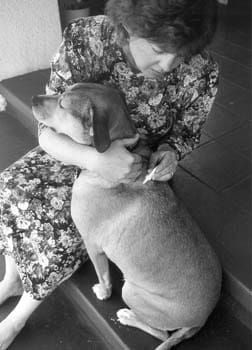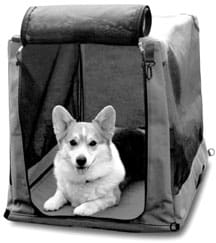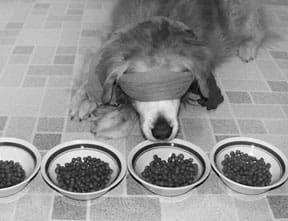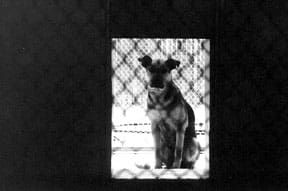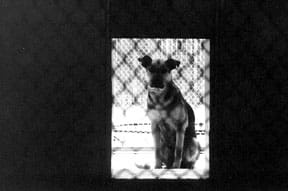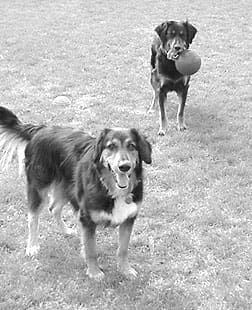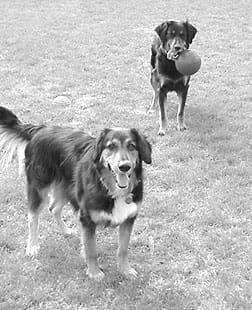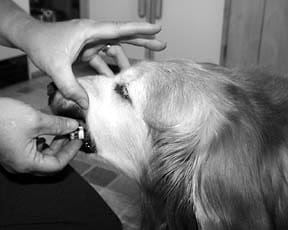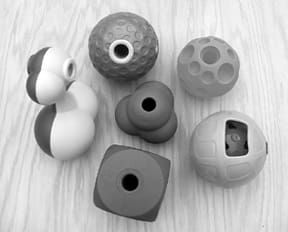It’s funny how special dogs come into one’s life. A friend had found Diamond at a dog show. Only seven months old, shed been returned to a breeder because of her dysplastic hips. The breeder planned to have her euthanized. With her big radar ears and eyes wise beyond her young age, she loved everything and everyone, especially young children. My friend offered to have her spayed and find her a good home in exchange for a reprieve, and in October 1993, she became my dog.
One of the first things I did was to make an appointment with a holistic veterinarian, Dr. Anne Rice of Williamstown, Michigan. I had hoped that Dr. Rice might have some new or different advice for dealing with Diamond’s hips. This dog should have no more vaccinations, she advised. And a natural diet would be best for her.
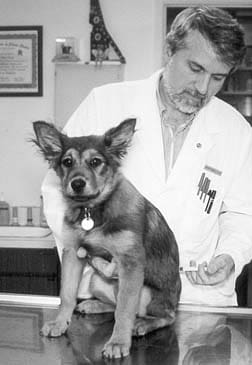
I’ve always taken good care of the animals entrusted to my care, but this advice did not work for me. Diamond received traditional care for her dysplastic hips, starting with one hip replacement surgery in 1995, and another in 1996. I was busy and bags of food were easy, so Diamond ate commercial pet food. I faithfully took her to a conventionally trained veterinarian for her annual vaccinations and the hip surgeries, and casually popped the heart worm prevention pills with chemical flea and parasite controls into her system, because that’s the way I had always done it.
But my care did not result in a problem-free dog! Diamond had numerous ear infections, constant problems with parasites, and teeth that always seemed to need cleaning, despite the promises of the special dental-plaque removal food.
One step forward, two steps back
It wasn’t until the winter of 1998, when I came across a book called Give Your Dog A Bone by Dr. Ian Billinghurst, that something finally clicked in my mind. A natural diet to boost the immune system? To eliminate the nagging problems that had plagued Diamond for so long? I liked the sound of that! In no time at all, I had a 30-pound box of frozen turkey necks in my freezer!
In very short order, things started improving for Diamond. Her ears cleared up. The thick, brown plaque wore off her teeth until they gleamed white. Her parasite problem vanished. I felt we were finally on the right track.
However, my vision of holistic health care was not very complete. Although I was feeding her a natural diet, I was not quite ready to abandon or alter her traditional veterinary care. So when I received a notice that Diamond was due to receive her annual vaccinations, I took her right in. In March 1999, just a few weeks after receiving those booster shots, Diamond became extremely arthritic. When she walked, she actually sounded like a creaky skeleton. I did add some chondroitin and glucosamine supplements to her diet, without much discernible improvement.
In August, one of her knee ligaments blew when she was playing with another dog, and had to be rebuilt surgically. The veterinary surgeon’s parting words were, “By the way, if that lump on her front leg changes AT ALL, get her in and have it taken off. It feels harmless, but keep an eye on it.”
I had noticed the lump before, but I hadn’t made much of it, since it didn’t seem to bother Diamond at all. I assumed she had bumped her leg while hunting groundhogs behind our barn, her favorite pastime.
Diamond’s overall health had me more worried. She looked much older than her six years. The supplements of chondroitin and glucosamine weren’t helping her arthritis much.
Eventually, as I fretted over my dear dog’s slow deterioration, I remembered Dr. Rice’s advice concerning vaccinations. Diamond’s arthritis had really kicked in right after the last round of vaccinations she had been given in March. Could there be a connection? I headed for the phone, wondering what Dr. Rice would have to say.
Holistic consultation
Thankfully, Dr. Rice was patient and understanding. She seemed to understand that it takes people time to absorb the holistic paradigm. This time, I listened much more attentively to what she had to say. After all, everything she had said to me years before had proven to be true. She talked to me about ways to eliminate the toxins I had been pumping into Diamond’s system. She explained the benefits of fasting, which frees up the digestive system to break down the toxins stored in the liver and other tissues. She reiterated her opinion that annual vaccinations were not necessary, especially for a six-year-old dog in poor health.
Since traditional care had not seemed to prevent a multitude of problems from afflicting Diamond, I was determined to follow all of Dr. Rice’s advice. I discontinued use of the chemical flea preventatives and began giving Diamond a flower essence product called Flea Free, which is given, a few drops a day, in the dog’s water. However, I also understood that purifying Diamond’s system might be a long-term project.
A new crisis
Around this time, I noticed that the lump on Diamond’s leg getting bigger. I brought Diamond to my traditional veterinarian, who removed the lump, and called me with the results a week later, on January 24, 2000. I knew we were in trouble when she said, “I’m SO sorry this happened to your dog.” The official diagnosis: hemangiopericytoma.
“What are my options?” I asked.
She kindly explained to me that it is impossible to completely remove this type of soft-tissue tumor surgically because they always recur, each time more aggressive than before. This usually lead to further surgeries and eventually amputation.
Dogs do surprisingly well on three legs, she offered. Radiation is also a possibility. These tumors have a low rate of metastasis. We could schedule an appointment for you at the University. Michigan State University Small Animal clinic is only 20 miles from my home.
I promised to think it over, but I knew the answer before I hung up the phone. There would be no more surgeries for Diamond. She’d been through enough already in her short life. Somewhat blindly, I made a trip to my local health food store and inquired about supplements to fight cancer. I came home with quite an assortment of products. I bought something that promised it was the ultimate antioxidant, and powerful herbal remedies that suggested they were what every body needs. I knew this was crazy, but I felt like I had to do something.
Diamond had a different idea. The dog who had always been willing to take anything suddenly had no use for my assortment of powders and pills. Just three weeks after having the tumor removed, the lump on Diamond’s leg was already as big as it was before the surgery.
Dr. Rice came out for a re-check. “What can I do?” I asked her. “I have a pile of supplements that she won’t touch.”
“This dog has come to teach you,” she said. “You have to listen to what her body tells you. The body knows what it needs.”
Her words constantly played through my head. The more I thought about it, the more I became convinced that Diamond could heal herself if she were given what she needed to work with. But what was the key?
Cancer treatment alternatives
I spent hours every night looking up information about canine cancer on the Internet. I found lots of information about the type of cancer that she had, and the typical treatment protocol was always the same: surgeries and radiation.
Then I swerved off in a new direction. I began looking for alternative treatments for humans with the same type of cancer. I found a website devoted to information about a German scientist and biochemist, Dr. Johanna Budwig, who had conducted extensive research on the healing properties of flaxseed oil combined with sulphurated proteins. She had had some success with curing cancer patients by giving them simple, natural foods with no chemicals or preservatives, as well as a supplement of flaxseed blended with low-fat cottage cheese.
About this same time, a friend suggested that I look up a website called Shirley’s Wellness Cafe. There I found lots of information about complementary and alternative pet care, including many testimonials from owners who were treating their animals various problems with a combination of … flaxseed oil and cottage cheese! Everyone seemed to be feeding 1/4 cup of cottage cheese plus one tablespoon of flaxseed oil three times daily.
Maybe this is it, I thought. On February 4, I started supplementing Diamond’s diet with the flaxseed/cheese mix, and I never looked back. Because she is less active than most dogs, I give her 1/4 cup low fat (1 percent) cottage cheese with 1 1/2 tablespoons of Barlean’s organic flaxseed oil two times a day (Barlean’s is the oil that Dr. Budwig recommends in the U.S.). I whip it until the oil is completely mixed into the cheese. When I place it in front of Diamond, she licks the dish clean and looks around for more.
The only vitamins I give her are a single 500-mg. Ester C (with bioflavonoids) gel cap, and one 400-iu vitamin E with selenium, both opened and mixed with her food daily. Several times a week, I give her a small amount of juiced vegetables, and I add a Vegyzme capsule to this, to help her digest the vegetables.
One day a week is fast day. On that day she gets none of her usual food, except for the oil/cheese mix and fresh water.
The fact that she’s still here with us already tells you that this protocol has worked. But how it worked still amazes me.
The tumor area on her leg continued to grow for the first three weeks after I began feeding Diamond the oil/cheese mix. I must have checked the puffy, lumpy area a hundred times a day. “This is going to work,” I told my husband.
“Don’t get your hopes up,” he cautioned. It was too late for that! I watched Diamond carefully during this time, and listened hard. Her arthritis was improving. She had more energy. Everything but her leg looked good.
On the morning of February 28, an amazing thing happened. The tumor definitely appeared smaller! And from that point on, it continued to shrink. By May 1, her leg looked completely normal. The last time my traditional veterinarian saw Diamond, she said, “I can’t even tell which leg it was!” She’s still kind of scratching her head over this case.
Today, Diamond is out back in the tall grass behind the barn, searching for groundhogs. Her arthritis is greatly improved, a plus from the flaxseed oil/cottage cheese mix that will always be a part of her diet, as will regular fasting.
The last time Dr. Rice saw her, she said, “Diamond looks great!” You can’t argue with success. I felt good about that, but it never would have happened if she hadn’t taught me the value of listening, searching for answers. Our animals bodies truly do know what they need. It’s up to us, as caretakers, to try and provide it.
-By Barb Hamlin


